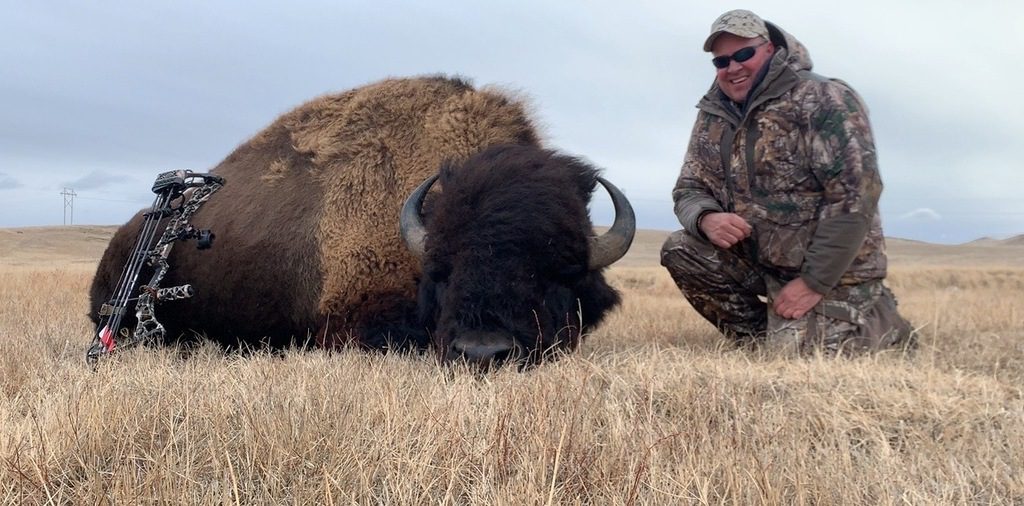
By Shawn L. McDonald
Killing a buffalo with a bow has been on my bucket list since I was a young child. Between seeing them on TV, old westerns and vacations out West, I grew fond of their history and sheer beauty. The two species of bison are also unique in that they’re only native to North America. The plains bison lived primarily in central North America, while wood bison lived in western Canada and all the way to Alaska and the Yukon. Through over-hunting by early settlers, bison were nearly wiped out in all of North America. Through conservation by hunters and ranchers, their numbers have reached estimates of 375,000 Plains bison and 6,000 wood bison.
In spring of 2019, I set out to check this hunt off my list. I knew I wanted to do the hunt out west on a large ranch to simulate as much as possible how our forefathers hunted them. I contacted the P Cross Bar Ranch and inquired about a hunt during the fall or winter. Unfortunately, I was told they were sold out of hunts for 2019 but could fit me in during the 2020 fall season. I decided to hold off on the hunt, not knowing where my crazy travel schedule would have me at that time. I’m a firm believer that everything happens for a reason, and I decided to plan on another trip to bow hunt in South Africa instead.
Preparations begin
Two months later, I received an email from Pat Fiedor with the P Cross Bar Ranch. He told me they had a cancellation and asked if I was still interested in a hunt for this year, to which I happily replied yes! I booked the hunt that day and set my calendar for a December trip to Wyoming.
I had taken the whole month of December off to hunt and get ready for my trip north. I killed a few does for the freezer and practiced for my rapidly approaching buffalo hunt. The last weekend of December I was finally making the much-anticipated trip to Gillette, Wyoming.
Morning hunt
The first morning of the hunt the wind blew 30 mph and the wind chill well below freezing. The absolute worst weather for bowhunting ever. It was actually a 70-degree difference in temperatures from Texas, with ice and snow in the forecast for the day. My guide Mick and I got lucky and located four bulls, and after glassing and judging, we picked out our target bull.
Mick, who’s also a bowhunter, and I put a plan together and the stalk was on! We crawled up a frozen creek to a draw where we were hoping the bulls would graze. We made a shooting lane and got as comfortable as possible in the zero-degree weather. There was only one tree and zero cover for as far as the eyes could see.
As the animals made their approach, I drew back on my Mathews Havalon bow and stared at all four of them, less than 10 yards away. Having animals that big and close to you will turn an atheist into a praying man very quickly. As I set my pin on my bull, the arrow fell off the rest and the small herd scattered. I had blown what was a textbook ambush and had a few choice words to say about myself.
Second attempt
Mick and I quickly regrouped and made another plan of attack. We quickly located the bulls again and we headed straight for another draw in a frozen creek ahead of their intended direction. As they inched towards us, I sat up, drew my bow and let the arrow fly. Bingo!
The arrow hit its mark—a perfect shot. The herd took off again and my bull couldn’t keep up, and soon lay down. Mick told me buffalo can take up to 30 minutes to die, even when hit in the vitals. We both agreed that I should attempt getting another arrow in him, just to be on the safe side.
I crawled on my hands and knees for a few hundred yards until I was within 35 yards of my bull. I again sat up, drew back and hit him again. Another perfect shot! He ran 100 yards and finally lay down for good.
Mission accomplished
They say every elk hunter hates elk hunting the minute they begin gutting, quartering and packing one out. With a buffalo, I had no idea! It took three of us 6 hours to gut, skin, and quarter that bull, and that was with the help of a pickup and a front-end loader. His estimated weight was close to 2,500 pounds.
Later that night Mick and Pat scored my bull at 66 3/8″ SCI. It ranked number 18 in the world for archery, and 72nd SCI overall! I could not have been happier. I had finally killed a buffalo with a bow, a dream I have had since I was a kid. I want to thank everyone at the P Cross Bar and Durham Ranches, the good Lord, and my wife Jocelyne, who puts up with my crazy bowhunting addiction.
If you’ve ever watched a singing mockingbird, you will have noticed that during his singing, he will suddenly fly straight up for two or three feet and turn a flip in the air—coming back to where he left his perch. The Kokernot Ranch bird did the same thing—up off the antenna and back again, never ceasing to sing.
One summer evening about 5 p.m., I sat in a lawn chair having a cool drink when the old bird came to the antenna and began to sing. I went into the house and got a scrap of paper and pen and came back to my chair. The old bird had been singing all the while. I waited until he mocked a sound that I could remember—the “bobwhite” of a quail. With that, I started counting his songs and making notes.
After a long spell of singing, he came back to the bobwhite call, and I counted the many different calls he had made: 34! I was so amazed that I Googled up the bird, to see if anyone else had counted a mockingbird’s calls during a long singing session. The report noted 35 different calls, so I guess my old bird may have forgotten one.
There has long been debate about mockingbirds. Do they mock other birds, or is their repertoire a natural inheritance? Experts point out the birds repeat the songs of other birds that do not exist in their locale. I think the mockingbird has an inherited vocabulary and doesn’t mock anything.
I enjoyed this mockingbird for about five or six years—then one summer he didn’t come back. He may have decided to change his singing spot, since he had never called in a mate. Or, he may have just died somewhere in his travels—I’ll never know.
All male “mockers” don’t sing like my old bird did. Where there are several birds in one area—both male and female—the male birds hardly ever sing. But when an old bird is all alone on a hill in Gonzales County, perched on a high TV antenna, he will sing his heart out, hoping that some far-away female will hear him and join his company. Woe is the life of a lonely mockingbird.



